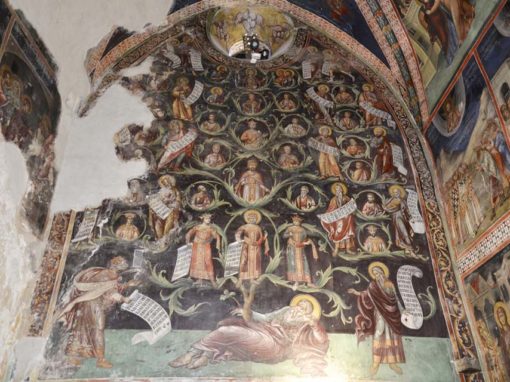The Panagia Odigitria (Virgin Mary The Guide) Icon
One of the most remarkable icons is that of Panagia Odigitria dating back to 1474. It belongs to the local iconographer Minas, who also painted the famous church of Archangel Michael. The icon is kept and displayed in the Byzantine Museum of Pedoulas.
In the picture, we observe that the Virgin is holding Christ with one hand and with the other hand is pointing to Him. In this way, the Virgin is guiding Christ, who is not portrayed as an infant but as a child. With one hand, Christ holds a scroll and is blessing with the other. Both of them appear upright, facing towards the viewer.
The Virgin Mary is wearing a green shawl, a tunic with chrysanthemums and a dark red veil with purple lining. Christ is wearing a green tunic with golden linear shades and a yellow garment. His red halo, often appearing in 15th century icons in Cyprus, carries the revelation inscription O ΩΝ (meaning he who exists). The faces and bare parts of the body are formed with light gray coloration. Red lights cover the cheeks, the chin and the forehead. White linear lights are placed on the back, nose, lip and hands. The shape of the eyes is small and almond-shaped.
Location
Frescoes - Icons
Murals of the Church of Panagia Podithou
At the dawn of the 16th century, in 1502, the frescoes of the Panagia of Podithou Church in Galata, with Italian-Byzantine-style frescoes, are considered as a stage in the evolution of art in Cyprus. Its main features are bright colours and third-dimen
The Agios Nikolaos tis Stegis (St. Nicholas of the Shelter) Murals
The 12th century is considered as the golden age for Byzantine art in Cyprus, but also unique in the whole world, because the surviving ones from this period are limited. The frescoes that survive in Agios Nikolaos tis Stegis and especially those revea
The Church of Panagia Asinou Frescoes
The church of Panagias Forviotissas, better known as Panagia Asinou, is built southwest of Nikitari village. The interior of the church of Panagia Asinou is documented. The frescoes that survive today belong to different chronological periods. The olde
The Monastery of Agios Ioannis (St. John) Lambadistis Frescoes
As seen in the decor and frescoes, the monastery flourished during the Byzantine period, as well as during the French Occupation (1191-1489) and the Venetian domination (1489-1571). The frescoes were created in different times, from the 11th to the 16t











